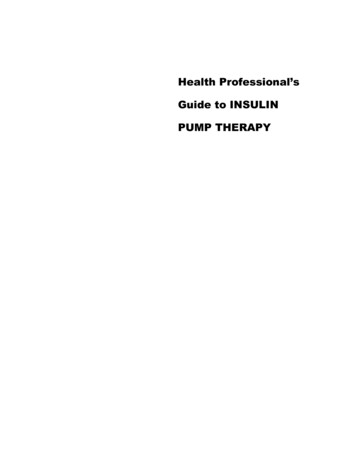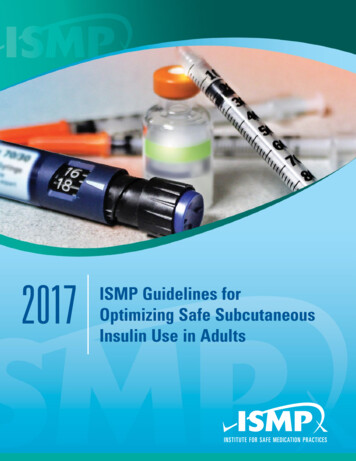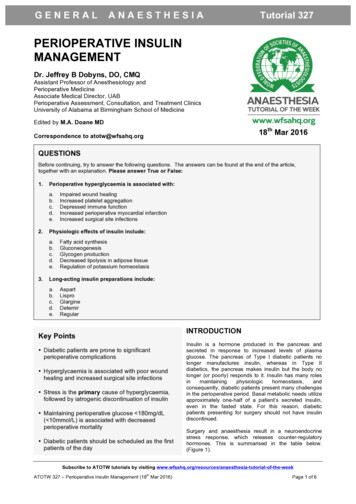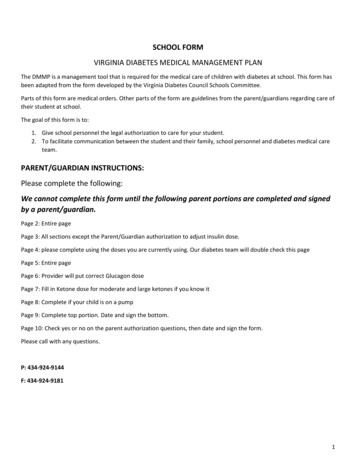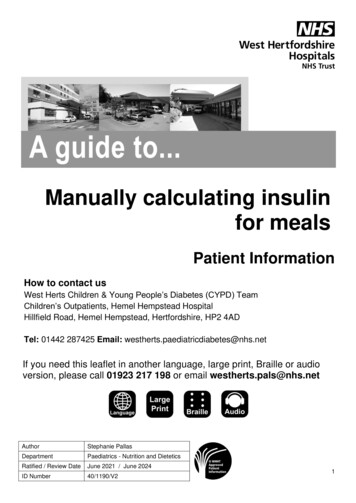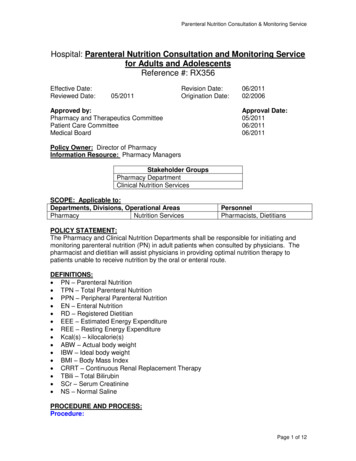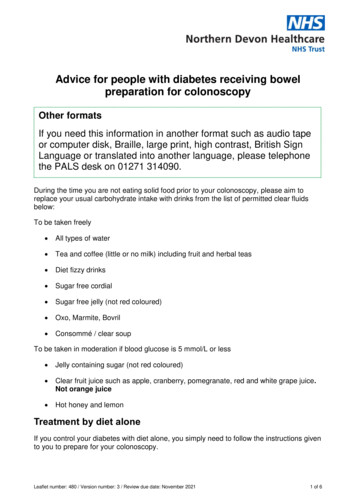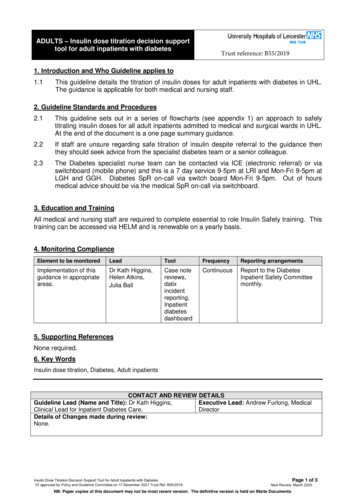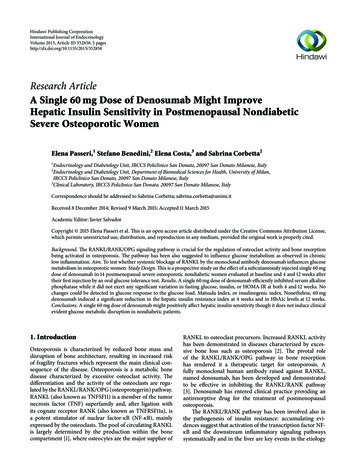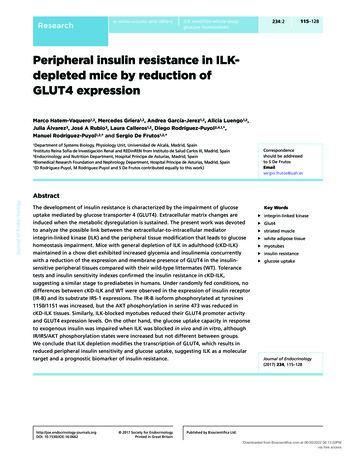
Transcription
Researchm hatem-vaqueroand othersILK modifies whole-bodyglucose homeostasis234:2115–128Peripheral insulin resistance in ILKdepleted mice by reduction ofGLUT4 expressionMarco Hatem-Vaquero1,2, Mercedes Griera1,2, Andrea García-Jerez1,2, Alicia Luengo1,2,Julia Álvarez3, José A Rubio3, Laura Calleros1,2, Diego Rodríguez-Puyol2,4,1,*,Manuel Rodríguez-Puyol1,2,* and Sergio De Frutos1,2,*1Departmentof Systems Biology, Physiology Unit, Universidad de Alcalá, Madrid, SpainReina Sofía de Investigación Renal and REDinREN from Instituto de Salud Carlos III, Madrid, Spain3Endocrinology and Nutrition Department, Hospital Príncipe de Asturias, Madrid, Spain4Biomedical Research Foundation and Nephrology Department, Hospital Príncipe de Asturias, Madrid, Spain*(D Rodríguez-Puyol, M Rodríguez-Puyol and S De Frutos contributed equally to this work)Correspondenceshould be addressedto S De FrutosEmailsergio.frutos@uah.es2InstitutoJournal of EndocrinologyAbstractThe development of insulin resistance is characterized by the impairment of glucoseuptake mediated by glucose transporter 4 (GLUT4). Extracellular matrix changes areinduced when the metabolic dysregulation is sustained. The present work was devotedto analyze the possible link between the extracellular-to-intracellular mediatorintegrin-linked kinase (ILK) and the peripheral tissue modification that leads to glucosehomeostasis impairment. Mice with general depletion of ILK in adulthood (cKD-ILK)maintained in a chow diet exhibited increased glycemia and insulinemia concurrentlywith a reduction of the expression and membrane presence of GLUT4 in the insulinsensitive peripheral tissues compared with their wild-type littermates (WT). Tolerancetests and insulin sensitivity indexes confirmed the insulin resistance in cKD-ILK,suggesting a similar stage to prediabetes in humans. Under randomly fed conditions, nodifferences between cKD-ILK and WT were observed in the expression of insulin receptor(IR-B) and its substrate IRS-1 expressions. The IR-B isoform phosphorylated at tyrosines1150/1151 was increased, but the AKT phosphorylation in serine 473 was reduced incKD-ILK tissues. Similarly, ILK-blocked myotubes reduced their GLUT4 promoter activityand GLUT4 expression levels. On the other hand, the glucose uptake capacity in responseto exogenous insulin was impaired when ILK was blocked in vivo and in vitro, althoughIR/IRS/AKT phosphorylation states were increased but not different between groups.We conclude that ILK depletion modifies the transcription of GLUT4, which results inreduced peripheral insulin sensitivity and glucose uptake, suggesting ILK as a moleculartarget and a prognostic biomarker of insulin I: 10.1530/JOE-16-0662 2017 Society for EndocrinologyPrinted in Great BritainKey Wordsff integrin-linked kinaseff Glut4ff striated muscleff white adipose tissueff myotubesff insulin resistanceff glucose uptakeJournal of Endocrinology(2017) 234, 115–128Published by Bioscientifica Ltd.Downloaded from Bioscientifica.com at 06/30/2022 06:13:02PMvia free access
Researchm hatem-vaqueroand others234:2ILK modifies whole-bodyglucose homeostasis116Journal of EndocrinologyIntroductionType 2 diabetes and metabolic syndrome (MS) arecharacterized by high blood glucose levels as aconsequence of inappropriate peripheral glucose uptake.The insulin-responsive facilitative glucose transporterGLUT4 is strongly expressed in striated muscle andwhite adipose tissue (WAT), which are responsible forglucose disposal in postprandial state (Shepherd & Kahn1999); therefore, the total amount of GLUT4 expressionhas been directly related with whole-body glucosehomeostasis by affecting glucose transport in these tissues(Kern et al. 1990, Shepherd & Kahn 1999, Matsui et al.2006, Karnieli & Armoni 2008). Supporting this concept,transgenic GLUT4 knockdown or overexpression inanimal models displayed, respectively, diminished orenhanced peripheral glucose utilization (Hansen et al.1995, Zisman et al. 2000, Wallberg-Henriksson & Zierath2001, Minokoshi et al. 2003, Atkinson et al. 2013). Infact, human studies have proposed that during type 2diabetes, MS and aging, GLUT4 expression is reducedin peripheral tissue, which may play a role in increasinginsulin resistance (Shepherd & Kahn 1999, Gaster et al.2001, Zeyda & Stulnig 2009). Moreover, some medicaltherapies for type 2 diabetes-like glitazones are able toincrease total GLUT4 levels and improve glucose uptake(Bähr et al. 1996, Hammarstedt et al. 2005). In addition,glucose uptake mechanism is regulated by the modulationof downstream effectors of insulin-mediated signaling,which promotes GLUT4 translocation from the reservoirvesicles to the plasma membrane (Carnagarin et al. 2015).Quantitative and qualitative changes in extracellularmatrix (ECM) proteins are characteristic of sustainedinsulin resistance (Berria et al. 2006, Williams et al. 2015).ECM proteins bind to integrins, which are clustered infocal adhesion complexes connected to the cytoskeletonand are able to transmit morphological and geneexpression changes (Wu & Dedhar 2001). Thus, it could bethe case that ECM-focal adhesion changes may modulateglucose transporters. Indeed, in vitro, transgenic and type2 diabetes animal models have shown integrin subunitbeta 1 (ITGB1) as a modulator of GLUT4 (Guilherme &Czech 1998, Zong et al. 2009). As part of the ITGB1-focaladhesion complex, the integrin-linked kinase (ILK) hasbeen suggested to modulate capillarization of the musclefrom diet-induced insulin resistant mice (Kang et al.2016). To elucidate the role of ILK in the insulin-sensitiveperipheral tissues concerning the regulation of the wholebody glucose homeostasis, we studied the effect of ILKdepletion over the expression of GLUT4, its I: 10.1530/JOE-16-0662 2017 Society for EndocrinologyPrinted in Great Britainwith insulin signaling and the consequent impact on theglucose uptake capacity.Materials and methodsConditional ILK knockdown mice (cKD-ILK)All procedures involving animals were approved by theInstitutional Animal Care and Use Committee of theUniversity of Alcalá and conformed to Directive 2010/63/EU of the European Parliament. We have implementedcKD-ILK mice model previously (Serrano et al. 2013, CanoPeñalver et al. 2014, 2015). Briefly, general inactivation ofthe Ilk gene was accomplished by crossing C57Bl/6 micehomozygous for the floxed Ilk allele, flanked by loxP sites(LOX) with homozygous BALB/cJ strain mice carrying aCMV-driven tamoxifen-inducible CreER (T) recombinasegene (CRE); three-month-old male CRE-LOX miceweighing 20–28 g were injected intraperitoneally (i.p.)with 1.5 mg of 4-hydroxytamoxifen (TX, Sigma-Aldrich)or vehicle (VH, corn oil/ethanol, 9:1, Sigma-Aldrich)once a day for five consecutive days. Three weeks afterthe injections, the tail DNA was genotyped by PCR. TheTX-treated CRE-LOX mice displaying successful depletionof ILK were termed cKD-ILK and the VH-treated CRE-LOXwere termed wild-type (WT) mice. Once the experimentswere terminated, the mice were killed, and cardiac leftventricle, slow-twitch (red) fibers from the vastus lateralis,epididymal and mesenteric fat depots were dissected. SeeSupplementary methods for further details (see section onsupplementary data given at the end of this article).Myotubes culture, transient transfections andpharmacological treatmentsMouse myoblasts cell line (C2C12; ATCC) were induced todifferentiate into myotubes and transfected (Metafectenesi ; Biontex, Munich, Germany) with a combination of40 nM different small interfering RNAs against Ilk (si-ILK,Santa Cruz) or 20 nM scrambled siRNAs as control (CT,Thermo Fisher Scientific). The silencing process took48 h, and cells were processed or treated after that time.To pharmacologically inhibit the ILK, myotubes weretreated for 24 h with 3 µM ILK inhibitor CPD-22 (MerckMillipore) or vehicle (CT) (Mamuya et al. 2016). In someexperiments, ILK-depleted myotubes were transfectedovernight with the luciferase reporter plasmid for humanPublished by Bioscientifica Ltd.Downloaded from Bioscientifica.com at 06/30/2022 06:13:02PMvia free access
Researchm hatem-vaqueroand othersGLUT4 promoter (Knight et al. 2003). See Supplementarymethods for further details.Journal of EndocrinologyGlucose, insulin and pyruvate tolerance tests (GTT, ITTand PTT): glycemia and insulinemia determinationsAfter 16 h fasting, mice were intraperitoneally (i.p.)injected with glucose (2 mg per g of body weight, SigmaAldrich) or sodium pyruvate (2 mg per g of body weight,Sigma-Aldrich). 4 -h fasting mice were i.p. injected withinsulin (0.75 U per kg of body weight, Actrapid, NovoNordisk A/S). At different time lapses, blood glucose wasmeasured via tail bleeding using a glucometer (AccuCheck Aviva; Roche).Insulinemia was analyzed from submandibularvein plasma (Cloud-Clone Corp. ELISA kit, Houston,USA) (Ayala et al. 2010). To provide a reliable approachto formal measures of insulin resistance and sensitivity,the homeostasis model assessment of insulin resistance(HOMA-IR, fasting glycemia in mg/dL multiplied byfasting insulinemia in µU/mL, divided to 405) and thequantitative insulin sensitivity check index (QUICKI,1 divided to log fasting insulinemia in µU/mL pluslog fasting glycemia in mg/dL) values were calculated(Bowe et al. 2014). See Supplementary methods forfurther details.ILK modifies whole-bodyglucose homeostasis234:2117homogenized, and equal amounts were separated on SDSpolyacrylamide gels, transferred to membranes, blockedand incubated with specific antibodies. Immunoblotswere developed, and the densitometries were measured.See Supplementary methods for further details.Differential centrifugation of subcellular fractionsThe differential centrifugation was performed as describedpreviously (Cano-Peñalver et al. 2014). Briefly, tissues fromfed and insulin-treated mice were homogenized in isolationsolution (250 mM sucrose and 10 mM Tris, and protease/phosphatase inhibitors, pH 7.5). The supernatantsobtained in 2 serial centrifugations, at 4000 g for 10 minat 4 C to remove cell debris and nuclear fragments, werecentrifuged at 17,000 g for 20 min at 4 C. The obtainedpellet was suspended in lysis buffer (commented above)to facilitate homogenization and corresponds to the highdensity plasma membrane (PM) fraction. The supernatantswere spun to 200,000 g for 60 min, and these pellets weresuspended in the same volume of lysis buffer as PM andrecorded as the low-density, vesicle-enriched intracellularmembrane fraction (IM). 30 µL aliquots of each fractionper sample were subjected to immunoblot analysis. ThePM/IM densitometry comparatives were representative ofsubcellular cytoplasm (vesicular) vs plasmatic membranesGLUT4 location.Acute insulin stimulation in vivoFour -hour fasted mice were i.p. injected with anexogenous insulin bolus (0.75 U per kg of body weight,Actrapid, Novo Nordisk A/S) or saline. After 30 min, micewere killed, and the cardiac left ventricle was rapidlyexcised for subsequent analysis.Reverse transcription–quantitative polymerase chainreaction (RT-qPCR)Total RNA from animal or cell samples was extractedwith Trizol, and RT-qPCR was performed as describedpreviously (Cano-Peñalver et al. 2014, 2015). For relativequantification, 2 ΔΔCT normalized gene expressionmethod was used. See Supplementary methods forfurther details.Glucose uptake assayGlucose uptake was performed as described previously(Nedachi & Kanzaki 2006, Wang et al. 2012). Briefly, freshlyexcised cardiac left ventricle, ILK-depleted or inhibitedmyotubes were incubated in deprived DMEM with orwithout insulin (100 nM) for 15 min before adding 0.1 mMof the fluorescent d-glucose analog y-glucose(2-NBDG,Sigma-Aldrich); after 30 min incubation, free 2-NBDG waswashed out 3 times with cold PBS. Rates of glucose uptake,determined as the intracellular fluorescence (VICTORX4,PerkinElmer), were calculated after subtraction ofautofluorescence from negative control without 2-NBDGand expressed as arbitrary units (a.u.).StatisticsProtein extraction and immunoblot analysisImmunoblots were performed as described previously(Cano-Peñalver et al. 2014, 2015). Tissues or cells werehttp://joe.endocrinology-journals.orgDOI: 10.1530/JOE-16-0662 2017 Society for EndocrinologyPrinted in Great BritainThe data shown are represented as the means s.e.m. ofa variable number of experiments detailed in the figurelegends. Student’s t-test was used for 2 samples, andPublished by Bioscientifica Ltd.Downloaded from Bioscientifica.com at 06/30/2022 06:13:02PMvia free access
Researchm hatem-vaqueroand othersILK modifies whole-bodyglucose homeostasis234:21181- or 2-way analysis of variance (ANOVA) was used for 2 samples, with a paired or unpaired design followedby a multiple comparison test. Values of P 0.05 wereconsidered statistically significant.Journal of EndocrinologyResultsWe previously reported a mice model in which the sixthand seventh exons of the Ilk gene were able to be excidedduring young adulthood once they are injected with TX(Serrano et al. 2013, Cano-Peñalver et al. 2014, 2015).Three weeks later, the adult mice displaying successful ILKdepletion (cKD-ILK) and control littermates (VH-treated,WT) were used.cKD-ILK and WT mice were fed with a normal chowdiet, and their body weight gains and food intake werenormal within the monitoring period (body weightsin g at the time of the experiments, mean s.e.m.:WT 26.3 1.1; cKD-ILK 28.3 1.8). Figure 1A showsthat blood glucose levels, in either randomly fed or after16 h fasting conditions, were significantly higher in cKDILK when compared to WT. CRE-driven mice models havebeing extensively used in functional metabolism analyses(Zong et al. 2009), but some changes in metabolismhave been reported immediately after TX injections(Hesselbarth et al. 2015); in our parental CRE-mice3 weeks after the TX administration stated, we confirmedthe lack of a direct effect of TX on glycemia (16 h fastingglycemia, mg/dL, mean s.e.m.: CRE VH 64.2 3.5;CRE TX 61.0 2.3). Figure 1B shows that insulin levelswere higher in cKD-ILK under fed but not under fastingconditions compared with WT. We next examinedchanges in plasma glucose and insulin concentrationsafter the i.p. glucose administration during GTT.Figure 1C shows similar profiles of blood glucose timecourses in both groups, and the AUC from GTT curveswere not different (mean s.e.m.: WT 458 72; cKDILK 416 63), similar as observed in other insulinresistance models (Zisman et al. 2000, Wang et al. 2013);however, Fig. 1D shows that insulinemia values andAUC during GTT were higher in cKD-ILK (mean s.e.m.,*P 0.05 vs WT: WT 2089 823; cKD-ILK 4848 1496*).To further confirm that cKD-ILK mice are insulin resistant,we analyzed the changes in plasma glucose after the i.p.insulin injection during ITT in both groups. Insulinbolus did not decrease the bloodstream glucose in cKDILK as efficiently as in WT (Fig. 1E), and cKD-ILK AUCbelow the baseline was lower (mean s.e.m., *P 0.05 vsWT: WT 164 30; cKD-ILK 117 4*). cKD-ILK showhttp://joe.endocrinology-journals.orgDOI: 10.1530/JOE-16-0662 2017 Society for EndocrinologyPrinted in Great BritainFigure 1Effect of ILK depletion in blood glucose homeostasis of conditional ILKknockdown (cKD-ILK) and wild-type (WT) mice. (A) Blood glucose levelsand (B) insulin levels from randomly fed or 16-h fasted mice. (C) Bloodglucose levels and (D) insulin levels during i.p. glucose tolerance test(GTT). (E) Blood glucose levels during i.p. insulin tolerance test (ITT).(F) Blood glucose levels during i.p. pyruvate tolerance test (PTT).Curves data are represented as WT (black circles) and cKD-ILK(open squares). Data are shown as mean s.e.m. N 6–9; *P 0.05 vs thesame time WT fasting, #P 0.05 vs fasting animals, P 0.05 vs WT fed.higher HOMA-IR values (mean s.e.m., *P 0.05 vs WT:WT 1.08 0.12; cKD-ILK 1.47 0.12*) and lower QUICKIvalues (mean s.e.m., *P 0.05 vs WT: WT 0.386 0.007;cKD-ILK 0.358 0.005) compared to WT.Insulin resistance can be characterized by eitherdecreased glucose uptake in peripheral tissue and/orenhanced hepatic glucose production. To assess whetheran underlying hepatic insulin resistance appeared in cKDILK, we examined changes in plasma glucose after an i.p.pyruvate administration during PTT (Fig. 1F), where bloodglucose time courses and AUC were not different betweengroups (mean s.e.m.: WT 254 82; cKD-ILK 142 34).The primary peripheral tissue responsible for thepostprandial glucose disposal in a physiological contextis the striated muscle. Thus, we studied whether theILK depletion was affecting the expression of thePublished by Bioscientifica Ltd.Downloaded from Bioscientifica.com at 06/30/2022 06:13:02PMvia free access
Researchm hatem-vaqueroand othersJournal of Endocrinologyglucose transporter GLUT4 in cardiac left ventricle andvastus lateralis.The glucose enters to the striated muscle cells mainlyvia GLUT1 and GLUT4, where GLUT4 is the insulinresponsive glucose transporter. Figure 2A shows reducedGlut4 mRNA levels in cKD-ILK cardiac tissue from bothfasting and randomly fed mice.Figure 2GLUT4 expression and membrane presence in the cardiac tissue ofconditional ILK knockdown (cKD-ILK) and wild-type (WT) mice. Cardiacleft ventricles from fasting or randomly fed WT and cKD-ILK wereprocessed. Glut4 (A) and Glut1 (B) mRNA levels fold change normalizedagainst Actb. Representative immunoblot and densitometric analysis ofGLUT4 (total extract) normalized against ACTIN (C). Membrane-enrichedsubcellular cardiac fractions were obtained by differential centrifugationand subjected to immunoblotting against GLUT4. Representativeimmunoblot and densitometric analysis of plasmatic membrane (PM)GLUT4 (D) or intracellular plasmatic membrane (IM) GLUT4 (E),normalized against total protein load using Ponceau membrane dye.PM/IM densitometries ratios (F). Data are shown as mean s.e.m. N 7–10.*P 0.05 vs WT.http://joe.endocrinology-journals.orgDOI: 10.1530/JOE-16-0662 2017 Society for EndocrinologyPrinted in Great BritainILK modifies whole-bodyglucose homeostasis234:2119No differences were observed in Glut1 mRNA levelsbetween groups in randomly fed mice (Fig. 2B). Figure 2Cshows reduced GLUT4 protein expression levels inrandomly fed cKD-ILK total cardiac tissue extract whencompared with WT. The magnitude of GLUT4 subcellularpresence in a postprandial state was analyzed bydetermining its content in the cardiac PM and IM extractsfrom randomly fed mice. When compared with WT, PMand IM fractions from cKD-ILK showed lower amountsof GLUT4 (Fig. 2D and E), because the total GLUT4decreased as described above. The PM/IM densitometryrates represented in Fig. 2F, which quantify the vesicularto the plasmatic membrane relocation of GLUT4,were similar in both groups. We confirmed cardiac ILKdepletion in randomly fed cKD-ILK mice (Fig. 3A andB) and its consequently reduced activity, determinedas the phosphorylation state in downstream substratesGSK3B on serine 9 and AKT on serine 473 (Fig. 3C andD) (Troussard et al. 2003, Edwards et al. 2005, GarcíaJérez et al. 2015). Since AKT is shared as a downstreamcomponent of the IR/IRS-1 network during the GLUT4modulation (Carnagarin et al. 2015), we also studiedthe AKT phosphorylation state on threonine 308, whichwas unchanged between groups (Fig. 3E). Similar AKTphosphorylation patterns were observed in fasting cKDILK cardiac tissue (Supplementary Fig. 1C and D).The cardiac ILK depletion in randomly fed mice wasnot affecting the expression levels of both IR isoformsIR-A and IR-B or IRS-1 (Fig. 4A, B and C). Althoughthe phosphorylation of IR B on tyr1150/1151 was notparticularly affected in fasting mice (SupplementaryFig. 1A), it was significantly upregulated in randomly fedcKD-ILK when compared to WT (Fig. 4D), in accordancewith the increased insulin production observed in Fig. 1B.Phosphorylation of IRS on different sites may affect itsinteraction with IR-B leading to a modulation of thesignal transduction. In order to analyze a known site toparticipate in this dynamic process (Weigert et al. 2008),we observed no changes in the phosphorylation stateof IRS-1 on serine 302 between groups in randomly fed(Fig. 4E) or fasting conditions (Supplementary Fig. 1B).GLUT4 content was also analyzed in the vastuslateralis muscle portion rich in red, slow-twitch fibers,which present higher basal GLUT4 expression thanthe rest of the fibers (Gaster et al. 2001). As observed incardiac tissue, cKD-ILK skeletal muscle have reduced ILKlevels (Fig. 5A and Supplementary Fig. 2A) and GLUT4expression under both fasting and fed states (Fig. 5B andSupplementary Fig. 2B). The phosphorylated isoformsPublished by Bioscientifica Ltd.Downloaded from Bioscientifica.com at 06/30/2022 06:13:02PMvia free access
Journal of EndocrinologyResearchm hatem-vaqueroand othersILK modifies whole-bodyglucose homeostasis234:2120Figure 3ILK expression and activity in the cardiac tissue ofconditional ILK knockdown (cKD-ILK) andwild-type (WT) randomly fed mice. Cardiac leftventricle from randomly fed WT and cKD-ILKwere processed. (A) Ilk mRNA levels fold changenormalized against Actb. Representativeimmunoblot and densitometric analysis of (B) ILKand (C) GSK3B phosphorylated at serine 9(P-GSK), AKT phosphorylated at serine 473 (D)and AKT phosphorylated at threonine 308 (E),normalized against total ACTIN, GSK3B (GSK) orAKT, respectively. Data are shown as mean s.e.m.N 7–10. *P 0.05 vs WT.levels of GSK3B on serine 9 and AKT on serine 473 werereduced in randomly fed cKD-ILK, in accordance with thereduced ILK content (Fig. 5C and D). Similar to cardiactissue, the vastus mRNA levels of Glut1, Ir-a and Ir-bwere not different between randomly fed animal groups(Supplementary Fig. 2C, D and E). Besides the striatedFigure 4Insulin receptor (IR)/IR substrate-1 (IRS-1)signaling pathway in the cardiac tissue ofconditional ILK knockdown (cKD-ILK) andwild-type (WT) randomly fed mice. Randomly fedWT and cKD-ILK (A) Ir-a, (B) Ir-b and (C) Irs-1mRNA levels fold change normalized againstActb. Representative immunoblot anddensitometric analysis of total cardiac tissueextracts IR beta chain (IR-B) phosphorylated ontyrosine 1150/1151 (D) and IRS-1 phosphorylatedon serine 302 (E), normalized against total IR-B orIRS-1, respectively. Data are shown as mean s.e.m.N 7–10. *P 0.05 vs WT.http://joe.endocrinology-journals.orgDOI: 10.1530/JOE-16-0662 2017 Society for EndocrinologyPrinted in Great BritainPublished by Bioscientifica Ltd.Downloaded from Bioscientifica.com at 06/30/2022 06:13:02PMvia free access
Journal of EndocrinologyResearchm hatem-vaqueroand othersILK modifies whole-bodyglucose homeostasis234:2121Figure 5ILK expression and activity and GLUT4 expression in the skeletal muscle ofconditional ILK knockdown (cKD-ILK) and wild-type (WT) mice. Vastuslateralis segment rich in red fibers from randomly fed WT and cKD-ILKwere processed. Representative immunoblot and densitometric analysisof (A) ILK and (B) GLUT4 normalized against total ACTIN, and (C) GSK3Bphosphorylated at serine 9 (P-GSK) and (D) AKT phosphorylated at serine473, normalized against total GSK3B (GSK) or AKT. Data are shown asmean s.e.m. N 7–10. *P 0.05 vs WT.muscle, the reduction of GLUT4 levels in adipose tissueobserved in altered metabolic states leads to a systemicglucose clearance impairment (Shepherd & Kahn1999, Armoni et al. 2007). Similar to the other insulinsensitive peripheral tissues studied above, Ilk and Glut4mRNA levels in the mesenteric and epididymal visceralWAT depots from cKD-ILK were reduced compared withWT (Fig. 6A, B, C and D). The phosphorylation state ofGSK3B on serine 9 and AKT on serine 473 was reduced inrandomly fed cKD-ILK as a consequence of ILK depletion(Fig. 6E and F). No changes were observed in Glut1 mRNAlevels (Supplementary Fig. 2F and G).In order to challenge the insulin response of the IR-B/IRS-1/AKT network from the cKD-ILK peripheral tissues,four -hour fasted mice were injected with a high dose ofinsulin (0.75 U/kg, i.p.) (Zong et al. 2009), and cardiacleft ventricles were isolated and processed 30 min later.The IR-B and AKT phosphorylation states, in tyrosines1150/1151 and serine 473, respectively, were highlyincreased in insulin-treated mice compared to fasting,http://joe.endocrinology-journals.orgDOI: 10.1530/JOE-16-0662 2017 Society for EndocrinologyPrinted in Great BritainFigure 6ILK expression and activity and GLUT4 expression in the visceral whiteadipose tissue (WAT). Mesenteric and epididymal WAT depots fromrandomly fed WT and cKD-ILK were processed. Ilk and Glut4 mRNA levelsfold change from mesenteric WAT (A and C) or epididymal WAT (B andD), normalized against Actb. Representative immunoblot anddensitometric analysis of (E) GSK3B phosphorylated at serine 9 (P-GSK)and (F) AKT phosphorylated at serine 473, normalized against totalGSK3B (GSK) or AKT, respectively, from mesenteric WAT. Data are shownas mean s.e.m. N 7–10. *P 0.05 vs WT.non-treated animals, but no differences between insulintreated WT and cKD-ILK groups were observed (Fig. 7A andB). We analyzed the GLUT4 PM/IM ratios in the cardiactissue from these insulin-stimulated animals. Figure 7Cconfirms that the intracellular translocation of GLUT4 tothe plasmatic membrane after the insulin bolus was notaffected by the lack of ILK, as we observed in randomlyfed mice (Fig. 2F). Finally, to test whether ILK depletionobserved in the tissue affects insulin sensitivity during theglucose transport, we studied the uptake capacity of theglucose-based fluorescent probe 2-NBDG in either ex vivobasal or short-term insulin-stimulated tissue (100 nM).Published by Bioscientifica Ltd.Downloaded from Bioscientifica.com at 06/30/2022 06:13:02PMvia free access
Journal of EndocrinologyResearchm hatem-vaqueroand othersFigure 7The insulin receptor (IR)/AKT/GLUT4 membrane translocation responseand glucose uptake capacity in the cardiac tissue of conditional ILKknockdown (cKD-ILK) and wild-type (WT) mice after a short-termexogenous insulin bolus. 4-h fasting WT and cKD-ILK mice were subjectedto a single bolus of insulin (0.75 µ/kg b.w., i.p.) or vehicle. 30 min later,cardiac left ventricles were processed. Representative immunoblot anddensitometric analysis of total cardiac tissue extracts IR beta chain (IR-B)phosphorylated in tyr 1150/1151 (A) and AKT phosphorylated at serine473 (B), normalized against total IR-B or AKT, respectively. Membraneenriched subcellular cardiac fractions were obtained from insulin-treatedmice by differential centrifugation and subjected to immunoblottingagainst GLUT4. Representative immunoblot of plasmatic membrane (PM)or intracellular plasmatic membrane (IM) GLUT4, and analysis of PM/IMdensitometries ratios, normalized against total protein load usingPonceau membrane dye (C). Cardiac explants from fasting mice wereincubated ex vivo with insulin (100 nM) for 15 min, and 2-NBDG (0.1 mM)was added for 30 min more. The intracellular 2-NBDG fluorescence foldchange was determined (D). Data are shown as mean s.e.m. N 7–10.*P 0.05 vs non-treated WT, #P 0.05 vs no treatment, P 0.05 vsWT insulin.Figure 7D shows that under non-stimulated conditions,there were no differences between groups. However, the2-NBDG uptake after 45 min of insulin stimulation waslower in cKD-ILK than in WT tissues, confirming thereduced levels of total GLUT4 observed in cKD-ILK (Fig. 2C).To better study the ILK-dependent GLUT4downregulation and its consequences into the glucoseuptake, we performed long-term blockade of ILK inmyotubes. Supplementary Figure 3 shows the myoblastcell line C2C12 differentiation to myotubes, withincreased levels of the myotube differentiation markersMYOG (Bolado-Carrancio et al. 2014) and GLUT4, asalready observed in other works (Tortorella & Pilch 2002).http://joe.endocrinology-journals.orgDOI: 10.1530/JOE-16-0662 2017 Society for EndocrinologyPrinted in Great BritainILK modifies whole-bodyglucose homeostasis234:2122To deplete ILK expression, differentiated myotubeswere silenced for 48 h with specific siRNAs against ILK priorto process the samples. Figure 8A shows that successfullyILK-depleted myotubes have reduced ILK activity inthese conditions, shown as decreased levels of GSK3Bphosphorylated in ser 9. Figure 8B shows that long-termILK-blocked myotubes exhibit decreased GLUT4 proteinlevels. The ILK-dependent transcriptional downregulationof Glut4 gene was confirmed by transfecting a reporterplasmid for human GLUT4 promoter in ILK-depletedmyotubes for 24 h after depletion (Knight et al. 2003).Figure 8C shows the decrease of the reporter activity inthe ILK-depleted myotubes. Besides reducing ILK content,we challenged its pharmacological blockade by treatingdifferentiated myotubes with ILK inhibitor CPD22 for24 h (Mamuya et al. 2016). Figure 8D shows no changesin the ILK expression when the myotubes are treatedwith CPD22. However, GSK3B phosphorylation levelsare reduced (Fig. 8E). Figure 8F shows reduced GLUT4 inCPD22-treated myotubes.In order to challenge the insulin response in ILKsuppressed cells, we stimulated for 40 min with a highdose of insulin (100 nM) in ILK-blocked or ILK-depletedmyotubes similarly as we previously did in cKD-ILK micecardiac tissue (Fig. 7). Figure 9 shows that the insulinstimulation increased the phosphorylation of IR-B ontyrosines 1150/1151 (Fig. 9A), IRS-1 on serine 302 (Fig. 9B)and AKT on serine 473/threonine 308 (Fig. 9C and D) inboth control and CPD22-treated myotubes comparedwith non-insulin-stimulated myotubes. However, nodifferences were observed under insulin-stimulatedconditions between control and CPD22-treated myotubes.Similar results were obtained in siRNA-based ILK-depletedmyotubes (Fig. 9E and F). Finally, to test whether longterm ILK
Immunoblots were performed as described previously (Cano-Peñalver et al. 2014, 2015). Tissues or cells were homogenized, and equal amounts were separated on SDS-polyacrylamide gels, transferred to membranes, blocked and incubated with specific antibodies. Immunoblots were developed, and the densitometries were measured.

